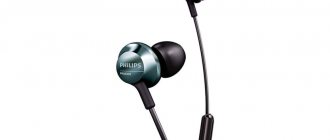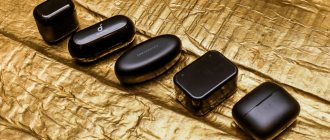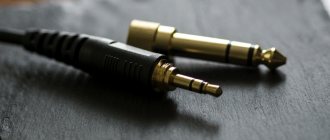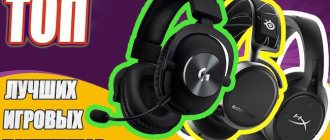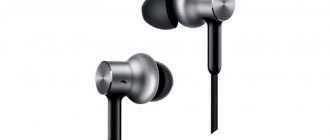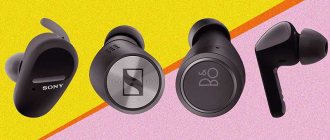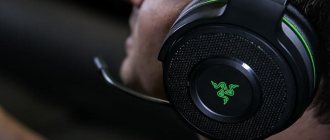The editors would like to thank the Soundmag online store for kindly providing the headphones for review.
People are gradually abandoning wires in headphones, and smartphone manufacturers are abandoning 3.5 mm jacks. The mass consumer is switching to Bluetooth headphones and there are fewer and fewer adherents of high-quality sound over a wire with a separate Hi-Fi player. This fact cannot be ignored and it was decided to make a rating of the best full-size Bluetooth headphones at the moment with all the stuffing: good sound, active noise reduction system, own applications and preferably support for aptX, aptX HD, LDAC codecs. These currently include the Sony WH-1000XM3, Bose QuietComfort 35 II and Bowers & Wilkins PX. All three pairs were guests at the gg and were actively used with a pair of modern smartphones Sony Xperia XZ2 and LG G6 with support for all of the above codecs. First, a couple of paragraphs of theory.
What is active noise cancellation?
We won’t go into detail; there are specialized resources for this and huge articles on this topic, so those who want to go deeper into the hardware can easily google it. The operating principle of an active noise reduction system is the interference of sound waves. These headphones have additional microphones that detect the level of background noise and additional speakers that create waves with the same amplitude and inverted phase. As a result of the interference of waves, they “cancel” each other and we do not hear external noise in the headphones. Of course, this is in theory, but in practice, creating a perfectly matching wave in antiphase is not so easy and all ANC (Active Noise Cancelling) systems are not ideal. The first idea for such an application of wave interference was proposed back in 1934 by the American scientist Paul Luge. Of course, the first application was military: in the 50s, this system was used to reduce noise in airplane cabins, and the first active noise-canceling headphones (also for aviation) were made by Willard Meeker in 1957. The first production model was released in 1986 by Bose (and again for aviation). The system was adapted for “consumer” use in 1989. Now there are a huge number of models with an active noise reduction system, in different form factors, so there is plenty to choose from.
What is aptX, aptX HD, LDAC and why is it needed?
A certain part of high-quality sound lovers are in no hurry to give up wires for obvious reasons: if you miss the quality of DACs, amplifiers and all the other electronic components that are needed to obtain a high-quality analog signal at the output, there are also losses when transmitting a digital signal from the source (smartphone, in most cases) to headphones. This is largely due to the limited bandwidth of Bluetooth. And here these same codecs come to the rescue - algorithms for encoding (and subsequent decoding) this very signal to obtain the maximum bitrate as a result. The first and most common codec is SBC, which only supports up to 328 kbps. The most common now are aptX and aptX HD developed by Qualcomm, which provide bitrates of 352 and 576 kbps, respectively. The most advanced in terms of quality is LDAC, developed by Sony, which can provide up to 990 kbps. But it has one significant drawback in the form of low prevalence: to work, both the smartphone (or player) and headphones must support LDAC. And if the first one is not so problematic: the codec was included in AOSP (Android Open Source Project) starting with Android 8.0 Oreo, then I have not seen wireless headphones with LDAC support from third-party manufacturers. Below is a diagram with a visual comparison of existing codecs:
A higher bitrate does not guarantee better sound quality (there are many other factors, including how well the recording itself was made). Well, now let’s move on to today’s trio of headphones, which, in the opinion of our editors, can rightfully bear the title of “best noise-canceling headphones.”
- General characteristics
Sony WH-1000XM3
The Sony WH-1000XM3 was announced at IFA 2022 in Berlin. Today, these are the top and most technologically advanced wireless noise-canceling headphones from the Japanese giant, with support for aptX, aptX HD and LDAC, touch and button controls, active noise reduction and a bunch of additional features. A good margin of parameters indicates that the model will not lose its relevance not only in 2022, but also in the next few years.
What do they look like and what's in the box?
Supplied in a large box made of black thick cardboard in a white cover with plenty of printing. Includes headphones, hard case, cable for wired connection, USB-C cable for charging, airplane adapter and instructions/warranties:
Sony WH-1000XM3 is made of matte plastic with a texture. The headphones look minimalist and very stylish, without any unnecessary decorative elements. The design is foldable, and the cups can be unfolded for convenient placement on the neck. On the left cup there are two mechanical buttons (turning on and adjusting noise isolation modes, you can assign a call to the Google Assistant to it) and an NFC tag, on the right there is a touch panel. The ear pads and the inside of the headband are made of leatherette with soft foam filling. The cups are moderately large and are fixed very movably for ease of use.
How convenient is it to use?
The headset is not too heavy, and the shape and size of the cups with ear pads are optimal and the ears fit completely inside. The clamping force is sufficient for a secure fit, but the headphones do not press. The Sony WH-1000XM3 can be used for hours without any discomfort (it can only be caused by the active noise reduction system, just like in other models, this is something specific to the body). The controls are interesting, but not perfect. Of the physical buttons, there are only power and ANC (Active Noise Cancelling) buttons; the rest of the control is done using the touch panel on the right earcup. Horizontal movements switch tracks, vertical movements adjust the volume, and touching is responsible for Play/Pause or accepting a call. One of the interesting features is that you can temporarily turn off the music and the noise reduction system by placing your palm on the right cup; this will be useful if you need to exchange a few phrases with someone. I found the headphones very easy to use, but, as practice has shown, not everyone likes the touch panel and takes some getting used to. The usual progressive USB-C port is used for charging.
There is a proprietary Sony Haeadphones Connect application, which displays basic information (charge level, codec used, transmission quality, etc.) and allows you to very flexibly customize the headphones to your liking. This applies to both the noise reduction system with internal pressure and the sound itself: there is an equalizer, surround sound emulation, and the DSEE HX enhancer, which (in theory) “completes” what was lost during MP3 compression. There is an adaptive mode in which the headphones detect the location and type of activity (rest, walking) and adjust the ANC themselves depending on the situation:
What about sound, noise cancellation and battery life?
The headphones are very good in terms of sound quality: it is adequately balanced in frequency, there are no significant peaks or dips. Very sensible detailing of low and mid frequencies, the highs are slightly smoothed out. There is enough bass, but it doesn’t penetrate the mid-frequency range and drowns out everything else. The mid frequencies are not failed, but it goes without saying that the combination of a Hi-Fi player with sensible wired headphones is far from being detailed. The manufacturer deliberately smoothed out the upper frequencies for versatility in terms of the audience (there are really a lot of HF-phobes). As for codecs, the difference between the ancient SBC and LDAC is very clearly felt (of course, when listening to high-quality tracks in FLAC, for example): mid and high frequencies become more detailed and controlled. With the help of proprietary equalizers and enhancers, you can tune the sound to suit your personal tastes. The built-in microphone copes with its task without any problems, the interlocutor can hear perfectly well even on the street.
Of course, Sony focuses on the noise cancellation capabilities of its Sony WH-1000XM3 headset: it is implemented really well. According to Sony, the headset can adapt ANC to a specific person, using data about the shape and size of the head, hair length and the presence or absence of glasses. For those who have not used such gadgets before, it is worth understanding that absolute silence in real conditions is impossible to achieve, but in this case the noise is really reduced to a minimum. According to the results of experiments on experimental acquaintances who were not previously familiar with active noise cancellation, in the first seconds they experience an extremely unusual feeling of vacuum, especially if ANC is turned on without music (this point applies to all headphones with active noise cancellation). I didn't have to use a headset on the plane, but the Sony WH-1000XM3 copes perfectly with subway noise. An additional advantage of this solution is that there is no need to increase the volume, which we like to do in transport or on the street with regular headphones.
Sony promises 30 hours of operation with noise reduction turned on, 38 hours without it, and 40 with noise reduction and no music. The headset was used for 2-3 hours a day with noise reduction and music, in this mode it lasted a week, so with battery life everything is fine. Plus, fast charging is supported: they promise that 10 minutes of charging will provide 5 hours of music listening. The headset takes about 4 hours to fully charge.
Sony WH-1000XM3
Best Wireless Noise Canceling Headphones
Sony WH-1000XM3 is a headphone that cannot be praised enough. These are the best wireless noise-canceling headphones on the market, giving the user maximum control over both noise-canceling options and sound profiles via the app. This model contains all the technological advances of Sony, which have been improved over the years. A large number of possible settings and impeccable sound along with high battery life (you can charge the headphones once a week, while fast charging is supported) do not leave any chance for competitors.
Buy
Editor's Choice
Criteria for choosing plugs
Regardless of the declared parameters, the degree of popularity of a particular model, the buyer, first of all, will pay attention to how much the headset he likes costs. If a person is only at the initial stage of choosing a Bluetooth or wired headset, then you should pay attention to the following aspects:
- Autonomy. For wireless headsets, this figure should reach 20 hours of battery life. The capacity of the case itself is important, as is the rate of recharging of the plugs.
- Sound. The TTX indicator is of great importance when choosing such a headset. You shouldn’t rely only on your own feelings, because a person listens to more than one song. Sound may vary depending on recording quality and volume. Everyone perceives sounds differently. Therefore, you should not rely on the opinions of marketers and manufacturers alone. Before purchasing, it would be a good idea to listen to a few of your favorite songs and compare the sound quality of different models.
- Design features. A modern headset may have special ear mounts, be equipped with wires, or be completely absent. In any case, it will be necessary to guess with the size and fastenings, which should 100% cope with the designated tasks. A microphone may be placed between the earbuds or there may be special neck mounts.
- Noise suppression. Before choosing one of the popular models, you should pay attention to such an aspect as the presence of noise reduction technology, which should be implemented in both the microphone and the speaker. Otherwise, it is recommended to give preference to a design with maximum sensitivity.
- The type of emitter used. Dynamic drivers are mounted in inexpensive and budget designs. They operate on the principle of an electromagnet. In expensive models, it is customary to use armature speakers, which transmit copied noise with increased accuracy.
- Is there a microphone provided? If they have a microphone, after connecting to the phone, they will work as a full-fledged headset. If there are none, then you will need to adapt and bring the smartphone to your face more often than required.
- Supporting aspects. Before delving into additional selection criteria, it should be noted that the human ear is not capable of perceiving the wide range of frequencies offered by the world's best vacuum plug manufacturers. The material of manufacture is important, but it does not play a fundamental role. Regardless of whether the accessories were produced in Russia or China, their quality standard will be the same.
Bose Quiet Comfort 35 II
The Bose QuietComfort 35 II is the manufacturer's current flagship model of wireless over-ear headphones. As you might guess, this is an updated version of the Bose QuietComfort 35 headphones, about which one could say that these are the best wireless headphones with active noise cancellation, but I will not draw any analogies since I did not use the first generation and cannot physically compare. In addition to active noise reduction, the model is interesting because it has official support for Google Assistant. Neither Ukrainian nor Russian languages have been introduced into Google Assistant yet, but everyone who is interested and curious can use English.
What do they look like and what's in the box?
The packaging and delivery are similar to the previous model in our article. The box is medium in size, with an outer “wrapper” made of soft white cardboard with printing, and a black box made of hard cardboard inside. The set includes headphones, a hard case, a charging cable, a cable for a wired connection and a small instruction brochure:
The headphones are made of plastic and metal (frame), the design is foldable, like the Sony WH-1000XM3. The cups are rotating, their outer part is plastic and painted with matte paint. It looks expensive and beautiful, but it collects fingerprints. Microphones for active noise reduction and Bose logos are located on the outer parts of the cups. To turn on and create a Bluetooth pairing mode, there is a slider switch on the right earphone. On the front there is a conversational microphone and an NFC tag. On the back are three mechanical playback control buttons with two LEDs next to them. Below is MicroUSB for charging. The left earphone has a connector for a wired connection and a large button for calling Google Assistant. It can be reassigned, which I did right away; as a result, it was used to switch noise reduction operating modes. The inside of the headband has a soft Alcantara insert. The ear pads are soft, with memory foam on the inside and leatherette on the outside. Inside the cups are the designations of the left and right earbuds. The headset turned out to be light, despite this, it does not feel cheap or unreliable. We have a black version, but there is also a silver version.
How convenient is it to use?
The headset is very light and comfortable, the clamping force of the headband is optimal. Bose QuietComfort 35 II can be used for hours without removing it without any discomfort. The ears fit completely inside the ear pads. Nothing presses, does not interfere, the headset perfectly adapts to the shape of the head. The ears do not sweat, although it is not summer yet and there are suspicions that this may change a little in the heat, but it is worth checking in practice. In general, of the trio of heroes in the article, the Bose QuietComfort 35 II seemed to me the most comfortable. It’s very easy to get used to the controls: there are only three buttons on the right earpiece. The two extreme ones are responsible for the volume, the middle one is multifunctional: click - Play/Pause, double click - the next track, triple click - the previous track, and is also responsible for answering/hanging up a call. The design of the headphones is foldable for easy transportation, and a MicroUSB connector is used for charging.
There is a proprietary Bose Connect application, in which you can change the name of the headset, switch between sources, adjust the noise reduction level, reassign the Google Assistant button, view current data on the charge, volume and track being played (including pulling up information from Google Music) and enable voice prompts . There is already a Russian-language localization, albeit crooked, with a funny accent:
What about sound, noise cancellation and battery life?
Perhaps the weakest point of the headset is the sound. No, it's not bad (especially considering that it's a Bluetooth headset). In general, for its category of gadgets, the sound is quite good, but worse than the other two models in this material. In terms of frequencies, the low frequencies are slightly raised, but not critically. Otherwise, there are no pronounced peaks or dips, but detail suffers greatly across the entire frequency range: some “cloudness” and blurriness are felt. In terms of sound, the Bose QuietComfort 35 II is optimal for creating a musical background, rather than attentive and thoughtful listening to music, which is quite forgivable. It's worth mentioning that Bose fundamentally still doesn't use aptX or aptX HD. It is sad.
Given Bose's track record of active noise cancellation, it's no surprise that the QuietComfort 35 II's noise reduction works great. In this regard, the Bose and Sony models are comparable: you can listen to music comfortably and comfortably even in a noisy metro. There are three modes of noise reduction: maximum (just for the metro and other extremely noisy places), medium, which is quite suitable for walking. Plus, active noise cancellation can simply be turned off. There were no complaints about the built-in microphone; it performs its functions without problems both indoors and outdoors.
The declared operating time in wireless mode with noise reduction function is 20 hours. In real conditions, this figure depends very significantly on the volume, and I got about 17 hours, which is also very good. One charge will probably be enough for a working week of travel to and from work. Charges in about 2 hours.
Bose Quiet Comfort 35 II
An updated model of popular headphones with active noise reduction.
Lightweight and very comfortable full-size Bluetooth headphones with an active noise reduction system with three operating modes. Equipped with NFC for quick connection to a smartphone and supports Google Assistant. To enable it, there is a separate Action button, which can be reassigned in the settings.
5 700 UAH
What does noise canceling in headphones mean?
Technologies that muffle the sounds of the outside world are used in the production of headphones for household use, as well as for models that are used in call centers and recording studios.
Three noise reduction options are used:
- active (ANC);
- passive;
- hybrid.
The first option involves installing additional microphones that pick up and filter external sounds. Headphones of this type not only reproduce music, but also produce waves that are opposite in polarity to the sounds of the external environment. These waves cancel each other out, so the user does not hear surrounding noise.
ANC technology is suitable for cutting off lower register sounds. For example, the hum of traffic, construction noise, whispers. The technology copes worse with external sounds of the upper register.
Active cancellation of external sounds improves the acoustic performance of the headphones, but ANC does not compensate for design flaws, such as loosely fitting ear pads.
Passive noise suppression is a technology that involves the use of materials and structures that mechanically block the flow of sounds. Earplugs work on the same principle.
A high degree of passive noise suppression is provided by full-size models with large cups that cover the ear like a cap. Over-ear models and earbuds provide poorer isolation from external sounds.
Is it worth paying extra for an active noise cancellation (ANC) system?
The price of headphones depends on the presence and type of noise reduction, so it doesn’t hurt to think about whether it’s worth it or overpaying to use ANC technology.
The decision is made taking into account how the device is planned to be used. If you need headphones for jogging in the park, then there is no point in overpaying. Models that muffle outside sounds are not safe to use outdoors. After all, you may not hear a car horn or other sounds signaling danger.
But in transport, using headphones with ANC is rational. It will also be useful to use such a device when working remotely if there are small children in the house.
Models from the “no-name” category, purchased for pennies on Aliexpress, despite the specified level of noise reduction, are unlikely to satisfy the user’s needs. There are a lot of fakes on this trading platform. It is better to buy goods from Chinese brands on Aliexpress, then the risk of getting a fake is small.
But you need to take into account one nuance: a number of people (5-7% of users) complain of headaches when using headphones with ANC. Therefore, before buying headphones with SAS, you should try to use them, borrowing them from friends for a while.
Bowers & Wilkins PX
Despite a very long track record and history that dates back to 1966, Bowers & Wilkins was in no hurry to release noise-canceling headphones, while its competitors already had a bunch of models. Finally, the company decided to take this step and Bowers & Wilkins PX became the first model from the British manufacturer with an active noise reduction system.
What do they look like and what's in the box?
Bowers & Wilkins PX comes in a large, beautiful white box with images of the headphones themselves and information about the main advantages. Inside are headphones, a soft carrying case, a 3.5 mm cable for a wired connection, a Type-C to Type-A cable for charging and connecting to a PC, and a small instruction booklet:
Bowers & Wilkins PX are perhaps the most interesting and unusual in terms of design and appearance in our selection today. The design combines massive metal parts: the headband frame is made entirely of metal, the outer parts of the earcups are also metal, and have Bowers & Wilkins logos on them. Around the metal inserts on the cups and on the top of the headband is nylon, which (theoretically) should be much more durable than leatherette or plastic. According to the official website, the ear pads and the inside of the headband are made of leather. Another constructive and interesting feature is the cable that connects the earcups. It is braided with fabric and located in an open groove on the cup mounts. The size of the headband is adjustable smoothly. The only not very convenient design point: the earcups rotate, but the headphones cannot be folded for transportation. Bowers & Wilkins PX is available in two versions: blue-gold and gray-black:
How convenient is it to use?
Of the entire selection, it took me the longest to get used to the Bowers & Wilkins PX: at first it seemed that the headband was too tight and there was too little padding in the ear pads. After some time, these strange sensations go away. The cups and ear pads are the optimal size and the ears fit completely inside them. Despite the noticeable weight in your hands, it does not strain your head even after prolonged use. All controls are located on the top earpiece. On the back are long buttons for volume control and Play/Pause (it also serves to switch tracks forward and backward by double and triple pressing, respectively). Below is a button to turn on active noise reduction and a power slider and switch to Bluetooth connection mode. At the bottom of the right earphone there is a 3.5 mm jack for a wired connection and a USB Type-C connector, for which special thanks. The headset can be used directly from a PC using the included cable, and using a Type-C cable on both sides, it can be connected directly to modern smartphones (this will be especially true for models without a 3.5 mm jack). The controls are simple and intuitive. The only thing I didn’t really like was the inclusion slider: it seemed to me that it was a little tight.
The proprietary application is designed to configure the headset and looks quite minimalistic. But for some reason it takes a long time to start up and connect to the headphones. There is a battery indicator, the ability to update firmware, reset, noise reduction and sensor settings. The noise reduction system (ambient noise filter) has three operating modes: office, city and flight, for each of them you can adjust the pass-through of voices. Another interesting feature is the wear sensors: the headset automatically pauses the music if you take it off. The sensitivity of the sensors is also adjustable:
What about sound, noise cancellation and battery life?
The Bowers & Wilkins PX uses 40mm dynamic drivers that are angled. The aptX and aptX HD codecs are supported, which is very pleasing (fortunately, there are smartphones at hand that support these codecs). The sound in the PX was pleasantly pleasing: it is balanced and not compressed, while driving and detailed, as much as possible in Bluetooth headphones. There is no outright muddiness in the mids or high frequencies and they are not failed. There is enough bass, it adds the necessary density and impact, but does not try to climb into the middle and push it back. The imaginary scene is very good, taking into account the class of headphones. High frequencies are fully present, as one would expect, they have been softened a little for HF-phobes, but without fanaticism. When using noise reduction, the sound does not become duller, which is what really affects many models of similar headsets.
It seemed to me that the noise reduction is just a little short of its competitors, but this can only be noticed in the noisiest places, and even this difference is minimal. As mentioned above, the software has three operating modes: office, city and flight. In addition to the intensity of noise reduction, for each of these modes you can adjust the pass-through of voices. This will be useful, for example, in an airport or train station terminal, so as not to miss the desired announcement.
The headset is powered by a built-in 850 mAh battery and promises 22 hours of operation on a single charge (via Bluetooth, with active noise cancellation). I got about 20 hours.
Bowers & Wilkins PX
The first Bowers & Wilkins Bluetooth headset with noise reduction.
A very unusual and interesting Bluetooth headset from a design point of view with pleasant sound, support for aptX, aptX HD codecs and an active noise reduction system.
11,600 UAH
Sennheiser PXC 550
While the Sennheiser PXC 550 isn't as environmentally responsive as some of the others on this list, it still has a few features that deserve a "smart" verdict. For example, they turn on automatically when the right capsule is unfolded from the transport position to the listening position. Accordingly, and vice versa, the Sennheiser switches off after returning to the transport position and thus saves energy.
Pairing with a smartphone is properly supported using NFC. The microcircuit is located in the left capsule, made in the form of a touchpad. This allows you to control the volume so you can skip parts you don't like. A light tapping interrupts the music to accept a phone call, which, by the way, works for both parties in excellent quality.
A slide switch in the upper right corner of the right capsule activates or deactivates two different levels of noise reduction. Level II is the highest level, where everything that is possible is hidden. There is another layer between this and the off mode: here the PXC 550 automatically adjusts to ambient noise, but not as effectively. Overall, noise reduction is almost at the same high level as that of Sony headphones.
The touchpad built into the right capsule responds instantly, which again makes work easier. However, it's even more tap-dependent than the Sony's: while a light tap is for playing and pausing music, a double tap activates the talk-through feature.
In terms of music reproduction, the Sennheisers are, as expected, in the same league as the Sony headphones, just with a slightly different voice. So there's a very slight drop off in the midrange for Sony listeners, where the Sennheiser dissolves a little better but sometimes provides a little more punch at higher frequencies.
The Sennheiser PXC 550 has different sound modes - “Club”, “Cinema” and “Speech” - they differ only in nuances. I liked the sound best when they are turned off. What Sennheiser especially likes is the fact that there are barely audible differences in sound whether the noise reduction is on or off.
Sennheiser was also convinced that they are actually not inferior in noise reduction to either s.Sony or Bose. In addition, they are much cheaper and therefore offer very good value for money.
Sennheiser PXC 550
The best sound from a renowned brand
The PXC 550 has effective noise cancellation, sounds great and is super equipped.
8,900 UAH
Bottom line
All four headsets presented in the rating are very good, each in its own way, and which one to choose is a personal matter. Each has its own advantages and disadvantages, there is no clear favorite: the Sony WH-1000XM3 seemed to me the most interesting in sound and the most technologically advanced, plus it lasts the longest on a single battery charge. On the other hand, not everyone will like touch controls and a huge number of settings. Bose QuietComfort 35 II and Bowers & Wilkins PX are simpler and more intuitive in terms of control. The Bose model (according to personal impressions) turned out to be the most convenient, but the sound is slightly inferior to the other two models, and the lack of aptX and aptX HD is somewhat surprising. Bowers & Wilkins PX is the most unusual and interesting in design model with pleasant sound, but it lags a little behind in the implementation of the noise reduction system. I think each of the above models would be a good buy for those looking for a flagship Bluetooth headset. Surely other manufacturers also have something to show in this category, write options for your “top” in the comments.
| Sony WH-1000XM3 | Bose Quiet Comfort 35 II | Bowers & Wilkins PX | Sennheiser PXC 550 | |
| Emitters | Dynamic, 40 mm | Dynamic | Dynamic, 40 mm | Dynamic |
| Frequency range | 4 Hz - 40,000 Hz (via cable) | Manufacturer does not indicate | 10 Hz - 20,000 Hz | 17 Hz - 23000 Hz |
| Acoustic design | closed | closed | closed | closed |
| Impedance | 41 Ohm | Manufacturer does not indicate | 22 Ohm | 46 Ohm |
| Sensitivity | 103 dB | Manufacturer does not indicate | 111 dB | 110 dB |
| Charging connector | USB Type-C | MicroUSB | USB Type-C | MicroUSB |
| Bluetooth version | Bluetooth 4.2 | Bluetooth 4.1 | Bluetooth 4.1 | Bluetooth 4.2 |
| Codec support | SBC, AAC, aptX, aptX HD, LDAC | SBC | SBC, AAC, aptX, aptX HD | aptX, aptX HD |
| NFC | Eat | Eat | No | Eat |
| Weight | 255 g | 235 g | 335 g | 227 g |
Fear of flying.
Many people are very afraid of flying. And some (according to the American Psychological Association: up to 20% of the entire population) are so terrified and stressed that they deliberately avoid vacations or jobs that require frequent flights.
If you also suffer from aerophobia, then Bose noise-canceling headphones will help solve this problem for you.
In a 2013 study, scientists found that listening to nature sounds and classical music significantly reduced stress levels during a flight.
British scientists in 2022 developed this research and found that anxiety can be reduced by 65%. In particular, they compiled a list of the 10 most relaxing compositions.
You can listen to them thanks to the free Spotify
compiled by Inc.com writer
Melanie Curtin
.
But classical music and natural sounds are not the only way out of the situation.
Since all headphones are from Bose
equipped with
Bluetooth
, you can use them to listen to mobile applications like
Headspace
. They will help you do breathing exercises during the flight, or even immerse yourself in meditation under the guidance of an experienced guide.


